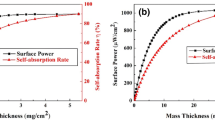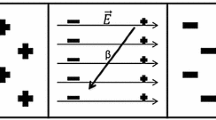Abstract
Betavoltaic cells (BCs) are promising self-generating power cells with long life and high power density. However, the low energy conversion efficiency (ECE) has limitations in practical engineering applications. Wide-bandgap semiconductors (WBGSs) with three-dimensional (3-D) nanostructures are ideal candidates for increasing the ECE of BCs. This paper proposes hydrothermally grown ZnO nanorod arrays (ZNRAs) for 63Ni-powered BCs. A quantitative model was established for simulation using the parameter values of the dark characteristics, which were obtained from the experimental measurements for a simulated BC based on a Ni-incorporated ZNRAs structure. Monte Carlo (MC) modeling and simulation were conducted to obtain the values of the β energy deposited in ZNRAs with different nanorod spacings and heights. Through the simulation and optimization of the 3-D ZNRAs and 2-D ZnO bulk structures, the performance of the 63Ni-powered BCs based on both structures was evaluated using a quantitative model. The BCs based on the 3-D ZNRAs structure and 2-D ZnO bulk structure achieved a maximum ECE of 10.1% and 4.69%, respectively, which indicates the significant superiority of 3-D nanostructured WBGSs in increasing the ECE of BCs.








Similar content being viewed by others
References
L.C. Olsen, P. Cabauy, B.J. Elkind, Betavoltaic power sources. Phys. Today. 65, 35–38 (2012). https://doi.org/10.1063/PT.3.1820
L.C. Olsen, Betavoltaic energy conversion. Energy Conver. 13, 117–124 (1973). https://doi.org/10.1016/0013-7480(73)90010-7
C.L. Weaver, R.J. Schott, M.A. Prelas et al., Radiation resistant PIDECα cell using photon intermediate direct energy conversion and a 210 Po source. Appl. Radiat. Isotopes. 132, 110–115 (2018). https://doi.org/10.1016/j.apradiso.2017.11.026
M.G. Spencer, T. Alam, High power direct energy conversion by nuclear batteries. Appl. Radiat. Isotopes. 6, 031305 (2019). https://doi.org/10.1063/1.5123163
C.J. Eiting, V. Krishnamoorthy, S. Rodgers et al., Demonstration of a radiation resistant, high efficiency SiC betavoltaic. Appl. Phys. Lett. 88, 1–38 (2006). https://doi.org/10.1063/1.2172411
D.Y. Qiao, X.J. Chen, Y. Ren et al., A Micro Nuclear Battery Based on SiC Schottky Barrier Diode. J. Microelectromech. S. 20, 685–690 (2011). https://doi.org/10.1109/JMEMS.2011.2127448
A.A. Svintsov, A.A. Krasnov, M.A. Polikarpov et al., Betavoltaic battery performance Comparison of modeling and experiment. Appl. Radiat. Isotopes. 137, 184–189 (2018). https://doi.org/10.1016/j.apradiso.2018.04.010
C. Munson, Q. Gaimard, K. Merghem et al., Modeling, Design, Fabrication and Experimentation of a GaN-based, 63Ni Betavoltaic Battery. J. Phys. D: Appl. Phys. 51, 035101 (2017). https://doi.org/10.1088/1361-6463/aa9e41
S. Butera, M.D.C. Whitaker, A.B. Krysa et al., Investigation of a temperature tolerant InGaP (GaInP) converter layer for a 63 Ni betavoltaic cell. J. Phys. D Appl. Phys. 50(34), 345101 (2017). https://doi.org/10.1088/1361-6463/aa7bc5
J. Dixon, A. Rajan, S. Bohlemann et al., Evaluation of a silicon 90Sr betavoltaic power source. Sci. Rep. 6, 38182 (2016). https://doi.org/10.1038/srep38182
W. Sun, N.P. Kherani, K.D. Hirschman et al., A three-dimensional porous silicon p-n diode for betavoltaics and photovoltaics. Adv. Mater. 17, 1230–1233 (2005). https://doi.org/10.1002/adma.200401723
J.W. Murphy, L.F. Voss, C.D. Frye et al., Design considerations for three-dimensional betavoltaics. Aip. Adv. 9, 065208 (2019). https://doi.org/10.1063/1.5097775
Y. Ma, N. Wang, J. Chen et al., Betavoltaic enhancement using defect-engineered TiO2 nanotube arrays through electrochemical reduction in organic electrolytes. Acs Appl. Mater. Inter. 10, 22174–22181 (2018). https://doi.org/10.1021/acsami.8b05151
C.S. Chen, N. Wang, P. Zhou et al., Electrochemically reduced graphene oxide on well-aligned titanium dioxide nanotube arrays for betavoltaic enhancement. Acs Appl. Mater. Inter. 8, 24638–24644 (2016). https://doi.org/10.1021/acsami.6b08112
Q. Zhang, R.B. Chen, H.S. San et al., Betavoltaic effect in titanium dioxide nanotube arrays under build-in potential difference. J. Power Sources. 282, 529–533 (2015). https://doi.org/10.1016/j.jpowsour.2015.02.094
C.S. Chen, J. Chen, Z. Wang et al., Free-standing ZnO nanorod arrays modified with single-walled carbon nanotubes for betavoltaics and photovoltaics. J. Mater. Sci. Technol. 19, 48–57 (2020). https://doi.org/10.1016/j.jmst.2020.03.040
N. Wang, Y. Ma, J. Chen, C.S. Chen et al., Defect-induced betavoltaic enhancement in black titania nanotube arrays. Nanoscale 10, 13028–13036 (2018). https://doi.org/10.1039/c8nr02824a
N. Wang, R.R. Zheng, T.X. Chi et al., Betavoltaic-powered electrochemical cells using TiO2 nanotube arrays incorporated with carbon nanotubes. Compos Part B-Eng. 239, 109952 (2022). https://doi.org/10.1016/j.compositesb.2022.109952
R.R. Zheng, Z. Wang, C.Q. Zhang et al., Photocatalytic enhancement using defect-engineered black mesoporous TiO2/CeO2 nanocomposite aerogel. Compos. Part B-Eng. 222, 109037 (2021). https://doi.org/10.1016/j.compositesb.2021.109037
M. Quintana, T. Edvinsson et al., Comparison of Dye-Sensitized ZnO and TiO2 Solar Cells: Studies of Charge Transport and Carrier Lifetime. J. Phys. Chem. C 111(2), 1035–1041 (2007). https://doi.org/10.1021/jp065948f
M. Wang, J. Bai, F.L. Formal et al., Solid-state dye-sensitized solar cells using ordered TiO2 nanorods on transparent conductive oxide as photoanodes. J. Phys. Chem. C 116, 3266–3273 (2012). https://doi.org/10.1021/jp209130x
H. Zhang, A.V. Babichev, G. Jacopin et al., Characterization and modeling of a ZnO nanowire ultraviolet photodetector with graphene transparent contact. J. Appl. Phys. 114, 7433–7473 (2013). https://doi.org/10.1063/1.4854455
X. Wang, Y. Han, J. Zhang et al., The design of a direct charge nuclear battery with high energy conversion efficiency. Appl. Radiat. Isotopes. 148, 147–151 (2019). https://doi.org/10.1016/j.apradiso.2019.03.040
M. Wu, J. Zhang, Design and simulation of high conversion efficiency betavoltaic battery based on a stacked multilayer structure. AIP Adv. 9, 075124 (2019). https://doi.org/10.1063/1.5094826
X.Y. Li, J.B. Lu, Y.M. Liu et al., Exploratory study of betavoltaic battery using ZnO as the energy converting material. Nucl. Sci. Tech. 30, 4 (2019). https://doi.org/10.1007/s41365-019-0577-3
Y.J. Yoon, J.S. Lee, I.M. Kang et al., Design and optimization of GaN‐based betavoltaic cell for enhanced output power density. Int. J. Energ. Res. 45(1), 799–806 (2021). https://doi.org/10.1002/er.5909
Z. Song, C. Zhao, F. Liao et al., Perovskite-betavoltaic cells, a novel application of organic-inorganic hybrid halide perovskites. Acs. Appl. Mater. Inter. 11, 32969–32977 (2019). https://doi.org/10.1021/acsami.9b09952
Y.P. Liu, X.B. Tang, Z.H. Xu et al., Influences of planar source thickness on betavoltaics with different semiconductors. J. Radioanal Nucl. Ch. 304, 517–525 (2015). https://doi.org/10.1007/s10967-014-3879-2
X.Y. Li, J.B. Lu, R.Z. Zheng et al., Comparison of time-related electrical properties of PN junctions and Schottky diodes for ZnO-based betavoltaic batteries. Nucl. Sci. Tech. 31, 18 (2020). https://doi.org/10.1007/s41365-020-0723-y
H. Demers, N.P. Demers, A.R. Couture et al., Three-dimensional electron microscopy simulation with the CASINO Monte Carlo software. Scanning. 33, 135–146 (2011). https://doi.org/10.1002/sca.20262
M. Chen, L.F. Hu, J.X. Xu et al., ZnO hollow-sphere nanofilm-based high-performance and low-cost photodetector. Small 7, 2449–2453 (2011). https://doi.org/10.1002/smll.201100694
X.B. Tang, Y.P. Liu, D. Ding et al., Optimization design of GaN betavoltaic microbattery. Sci. China Tech. Sci. 55, 659–664 (2012). https://doi.org/10.1007/s11431-011-4739-8
X.B. Tang, D. Ding, Y.P. Liu et al., Optimization design and analysis of Si-63Ni betavoltaic battery. Sci. China Technol. Sc. 55, 990–996 (2012). https://doi.org/10.1007/s11431-012-4752-6
H. Gao, S.Z. Luo, H.M. Zhang et al., Demonstration, radiation tolerance and design on a betavoltaic micropower. Energy 51, 116–122 (2013). https://doi.org/10.1016/j.energy.2012.12.042
C. Zhao, L. Lei, F. Liao et al., Efficiency prediction of planar betavoltaic batteries basing on precise modeling of semiconductor units. Appl. Phys. Lett. 117, 263901 (2020). https://doi.org/10.1063/5.0033052
S.H. Yang, Y.J. Lin, H.C. Chang et al., Effects of H2O2 treatment on the optical and structural properties of ZnO nanorods and the electrical properties of conductive polymer/ZnO-nanorod array diodes. Thin Solid Films 545, 476–479 (2013). https://doi.org/10.1016/j.tsf.2013.08.063
S.K. Cheung, N.W. Cheung, Extraction of schottky diode parameters from forward current-voltage characteristics. Appl. Phys. Lett. 49, 85–87 (1986). https://doi.org/10.1063/1.97359
S. Mridha, D. Basak, ZnO/polyaniline based inorganic/organic hybrid structure: Electrical and photoconductivity properties. Appl. Phys. Lett. 92, 42 (2008). https://doi.org/10.1063/1.2898399
Z. Yuan, Low-temperature growth of well-aligned ZnO nanorod arrays by chemical bath deposition for schottky diode application. J. Electron. Mater. 44, 1187–1191 (2015). https://doi.org/10.1007/s11664-015-3661-4
Y.L. Tao, M. Fu, A.L. Zhao et al., The effect of seed layer on morphology of ZnO nanorod arrays grown by hydrothermal method. J. Alloy Compd. 489, 99–102 (2010). https://doi.org/10.1016/j.jallcom.2009.09.020
S.V. Kurudirek, K.C. Pradel, C.J. Summers, Low-temperature hydrothermally grown 100 μm vertically well-aligned ultralong and ultradense ZnO nanorod arrays with improved PL property. J. Alloy Compd. 702, 700–709 (2017). https://doi.org/10.1016/j.jallcom.2017.01.273
M. Fang, Z.W. Liu, Controllable size and photoluminescence of ZnO nanorod arrays on Si substrate prepared by microwave-assisted hydrothermal method. Ceram Int. 43, 6955–6962 (2017). https://doi.org/10.1016/j.ceramint.2017.02.119
W. Shockley, H.J. Queisser, Detailed balance limit of efficiency of p-n junction solar cells. J. Appl. Phys. 32, 510–519 (1961). https://doi.org/10.1063/1.1736034
Author information
Authors and Affiliations
Contributions
All authors contributed to the study conception and design. Material preparation, data collection and analysis were performed by Zan Ding, Tong-Xin Jiang, Ren-Rong Zheng, and Na Wang. The first draft of the manuscript was written by Zan Ding. Writing—review—and editing of the manuscript were performed by Hai-Sheng San. Project administration and source support were performed by Li-Feng Zhang, Shi-Chao Liu, Xin Li, and Hai-Sheng San. All authors read and approved the final manuscript.
Corresponding authors
Additional information
This study was supported by the National Natural Science Foundation of China (Nos. 12175190 and U2241284), the National Key R&D Program of China (Nos. SQ2022YFB190165), the Natural Science Foundation of Fujian Province, China (No. 2022J02006), and the Special Funds for Central Government Guiding Shenzhen Development in Science and Technology, China (No. 2021Szvup066).
Supplementary Information
Below is the link to the electronic supplementary material.
Rights and permissions
Springer Nature or its licensor (e.g. a society or other partner) holds exclusive rights to this article under a publishing agreement with the author(s) or other rightsholder(s); author self-archiving of the accepted manuscript version of this article is solely governed by the terms of such publishing agreement and applicable law.
About this article
Cite this article
Ding, Z., Jiang, TX., Zheng, RR. et al. Quantitative modeling, optimization, and verification of 63Ni-powered betavoltaic cells based on three-dimensional ZnO nanorod arrays. NUCL SCI TECH 33, 144 (2022). https://doi.org/10.1007/s41365-022-01127-6
Received:
Revised:
Accepted:
Published:
DOI: https://doi.org/10.1007/s41365-022-01127-6




